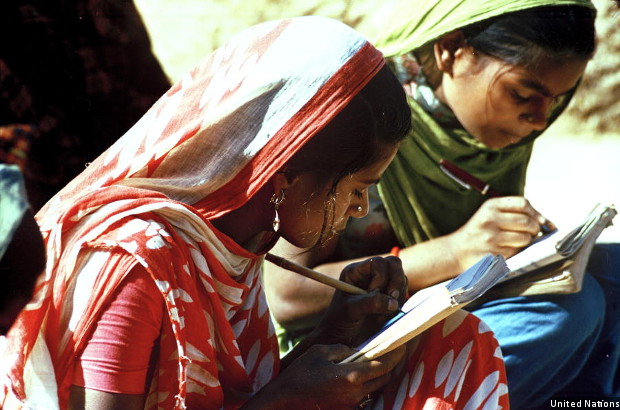4.5% Of Budget On Plans For Women. Enough?
Spending on women--who comprise 48% of India's 1.2 billion people--in union budget 2016-17 is Rs 90,624.76 crore ($13.3 billion) or 4.5% of government spending. This is a decline from 5% a decade ago in 2006 (Rs 28,737 crore or $6.4 billion) when gender-responsive budgeting was first started in India.
This money is spent on a variety of centrally administered programmes, which include saving girls from death, supporting rape victims, better health and nutrition for mothers and daughters, incentives to allow girls to be born and nurtured.
The consensus among representatives--from national parties, academia, industry and civil society--is that this is not enough. The experts were present at a post-budget discussion in New Delhi last week on "gender budgeting", organised by the UN Women India Office.
"Social inclusion is essential to growth"- @rebeccaunwomen #Budget2016 pic.twitter.com/WLjoRUALXY
— UN Women India (@unwomenindia) March 2, 2016
“The rationale for gender budgeting arises from recognition of the fact that national budgets impact men and women differently through the pattern of resource allocation," said this statement from the Ministry of Women and Child Development, explaining gender budgeting. "Women constitute 48% of India’s population, but they lag behind men on many social indicators like health, education, economic opportunities, etc. Hence, they warrant special attention due to their vulnerability and lack of access to resources.”
The budget for gender-specific programmes of the ministry fell by Rs 1,131 crore ($160 million) between 2014-15 and the next year.
The ministry is responsible for the implementation of major schemes, such as the Beti Bachao, Beti Padhao (save the girl child, educate the girl child), Integrated Child Development Services (ICDS) and National Nutrition Mission (NNM).
While most programmes have seen marginal increases in their allocations for the next financial year, the budget for the Indira Gandhi Matrtiva Sahyog Yojna (IGMSY), Indira Gandhi Maternal Relief Scheme, has almost doubled--from Rs 230 crore ($34.2 million) to Rs 400 crore ($60 million). This is, however, lower than the allocation in 2015-16 budget. The programme is a maternity benefit scheme that provides cash support to pregnant and lactating women who do not receive maternity leave.
The union government has reduced social welfare funding and has left it to the state governments to decide how they want to use money for social welfare, IndiaSpend has reported.
The Union government is giving more money to states unconditionally so that they can have more financial administration powers, but as we reported, state governments could not redeploy much of that money without the Centre's clearance.
GVL Narsimha Rao, spokesperson of the Bharatiya Janata Party (BJP), spoke about the government’s allocations for women. Free LPG connections for the poor and Mudra Scheme, a micro-finance scheme for entrepreneurship, would additionally benefit women and “we hope it will reflect in the outcomes in the coming years”, he said. The spokespersons of opposition parties--Manish Tewari of Congress and Brinda Karat of Communist Party of India (Marxist)--called the allocations merely an “accounting exercise”.
"The approach of gender responsive budgeting continues to be neglected in the budgeting process"Subrat Das, @CBGAIndia analyses #Budget2016
— UN Women India (@unwomenindia) March 2, 2016
India’s female workforce participation at 25.5% is lower than Somalia (37%), and about 43% of women of working age (15-59 years) only work at home, IndiaSpend has reported.
About 55% of all workers under the Mahatma Gandhi National Rural Employment Guarantee Act were women, as IndiaSpend reported, and the gender allocation under MGNREGA was Rs 12,833 crore ($1.9 billion), or 14% of the allocation for women.
Starting 2006, gender-specific allocations came under the purview of the Ministry of Women and Child Development, which was earlier a department under the Ministry of Human Resource Development.
"The needs of working women are lacking in #Budget2016" @brindacpim pic.twitter.com/GaFqO2nS3C
— UN Women India (@unwomenindia) March 2, 2016
"Do schemes like #makeinindia look at gender?"- Rohit Azad, prof of JNU on #Budget2016 pic.twitter.com/ZNxsOTheBy
— UN Women India (@unwomenindia) March 2, 2016
"What are the needs of women farmers?How do we operationalize their needs?"Yamini Mishra of @unwomenasia #Budget2016 pic.twitter.com/6TBLClDqtA
— UN Women India (@unwomenindia) March 2, 2016
(Tewari is an analyst with IndiaSpend.)
We welcome feedback. Please write to respond@indiaspend.org. We reserve the right to edit responses for language and grammar.
__________________________________________________________________
Liked this story? Indiaspend.org is a non-profit, and we depend on readers like you to drive our public-interest journalism efforts. Donate Rs 500; Rs 1,000, Rs 2,000.



